Low-Temperature Preparation of Tungsten Oxide Anode Buffer Layer via Ultrasonic Spray Pyrolysis Method for Large-Area Organic Solar Cells
Abstract
:1. Introduction
2. Results and Discussion
2.1.Characterization and Analysis of WO3 Films
2.2. Detailed Analysis of OSC Performances
2.3. Equivalent Circuit Model and Impedance Analysis
2.4. Mechanism of USP Coated Films
2.5. Large Area OSC
3. Materials and Methods
3.1. Fabrication Section
3.2. Measurement Method
4. Conclusions
Supplementary Materials
Acknowledgments
Author Contributions
Conflicts of Interest
References
- Guenes, S.; Neugebauer, H.; Sariciftci, N.S. Conjugated polymer-based organic solar cells. Chem. Rev. 2007, 38, 1324–1338. [Google Scholar] [CrossRef] [PubMed]
- Yu, J.; Zheng, Y.; Huang, J. Towards high performance organic photovoltaic cells: A review of recent development in organic photovoltaics. Polymers 2014, 6, 2473–2509. [Google Scholar] [CrossRef]
- Dennler, G.; Sariciftci, N.S. Flexible conjugated polymer-based plastic solar cells: From basics to applications. Proc. IEEE 2005, 93, 1429–1439. [Google Scholar] [CrossRef]
- Huang, J.; Wang, H.; Yan, K.; Zhang, X.; Chen, H.; Li, C.; Yu, J. Highly efficient organic solar cells consisting of double bulk heterojunction layers. Adv. Mater. 2017, 29, 1606729. [Google Scholar] [CrossRef] [PubMed]
- Scharber, M.C.; Koppe, M.; Gao, J.; Cordella, F.; Loi, M.A.; Denk, P.; Morana, M.; Egelhaaf, H.J.; Forberich, K.; Dennler, G. Influence of the bridging atom on the performance of a low-bandgap bulk heterojunction solar cell. Adv. Mater. 2010, 22, 367–370. [Google Scholar] [CrossRef] [PubMed]
- Kan, B.; Zhang, Q.; Li, M.; Wan, X.; Ni, W.; Long, G.; Wang, Y.; Yang, X.; Feng, H.; Chen, Y. Solution-processed organic solar cells based on dialkylthiol-substituted benzodithiophene unit with efficiency near 10%. J. Am. Chem. Soc. 2014, 136, 15529–15532. [Google Scholar] [CrossRef] [PubMed]
- Yu, G.; Gao, J.; Hummelen, J.C.; Wudl, F.; Heeger, A.J. Polymer photovoltaic cells: Enhanced efficiencies via a network of internal donor-acceptor heterojunctions. Science 1995, 270, 1789–1791. [Google Scholar] [CrossRef]
- Liu, Y.; Zhao, J.; Li, Z.; Cheng, M.; Ma, W.; Hu, H.; Jiang, K.; Lin, H.; Ade, H.; He, Y. Aggregation and morphology control enables multiple cases of high-efficiency polymer solar cells. Nat. Commun. 2014, 5, 5293. [Google Scholar] [CrossRef] [PubMed]
- Zhao, G.; He, Y.; Li, Y. 6.5% efficiency of polymer solar cells based on poly(3-hexylthiophene) and indene-C-60 bisadduct by device optimization. Adv. Mater. 2010, 22, 4355–4358. [Google Scholar] [CrossRef] [PubMed]
- Zheng, Y.; Wu, R.; Shi, W.; Guan, Z.; Yu, J. Effect of In Situ annealing on the performance of spray coated polymer solar cells. Sol. Energy Mater. Sol. Cells 2013, 111, 200–205. [Google Scholar] [CrossRef]
- Kong, T.; Wang, H.; Liu, X.; Yu, J.; Wang, C. Improving the efficiency of bulk heterojunction polymer solar cells via binary-solvent treatment. IEEE J. Photovolt. 2017, 7, 214–220. [Google Scholar] [CrossRef]
- Guo, F.; Li, N.; Fecher, F.W.; Gasparini, N.; Ramirez Quiroz, C.O.; Bronnbauer, C.; Hou, Y.; Radmiloviæ, V.V.; Radmiloviæ, V.R.; Spiecker, E. A generic concept to overcome bandgap limitations for designing highly efficient multi-junction photovoltaic cells. Nat. Commun. 2015, 6, 7730. [Google Scholar] [CrossRef] [PubMed]
- Zhou, Y.; Fuenteshernandez, C.; Shim, J.W.; Khan, T.M.; Kippelen, B. High performance polymeric charge recombination layer for organic tandem solar cells. Energy Environ. Sci. 2012, 5, 9827–9832. [Google Scholar] [CrossRef]
- Li, M.; Gao, K.; Wan, X.; Zhang, Q.; Kan, B.; Xia, R.; Liu, F.; Yang, X.; Feng, H.; Ni, W.; et al. Solution-processed organic tandem solar cells with power conversion efficiencies>12%. Nat. Photonics 2016, 11, 85–90. [Google Scholar] [CrossRef]
- Po, R.; Carbonera, C.; Bernardi, A.; Camaioni, N. The role of buffer layers in polymer solar cells. Energy Environ. Sci. 2011, 4, 285–310. [Google Scholar] [CrossRef]
- Li, G.; Chu, C.W.; Shrotriya, V.; Huang, J.; Yang, Y. Efficient inverted polymer solar cells. Appl. Phys. Lett. 2006, 88, 253503–253505. [Google Scholar] [CrossRef]
- Shrotriya, V.; Li, G.; Yao, Y.; Chu, C.W. Transition metal oxides as the buffer layer for polymer photovoltaic cells. Appl. Phys. Lett. 2006, 88, 073508. [Google Scholar] [CrossRef]
- Sun, Y.; Takacs, C.J.; Cowan, S.R.; Seo, J.H.; Gong, X.; Roy, A.; Heeger, A.J. Efficient, air-stable bulk heterojunction polymer solar cells using MoOx as the anode interfacial layer. Adv. Mater. 2011, 23, 2226–2230. [Google Scholar] [CrossRef] [PubMed]
- Chen, C.P.; Chen, Y.D.; Chuang, S.C. High performance and highly durable inverted organic photovoltaics embedding solution processable vanadium oxides as an interfacial hole transporting layer. Adv. Mater. 2011, 23, 3859–3863. [Google Scholar] [CrossRef] [PubMed]
- Shen, L.; Ruan, S.; Guo, W.; Meng, F.; Chen, W. Semitransparent inverted polymer solar cells using MoO3/Ag/V2O5 as transparent anodes. Sol. Energy Mater. Sol. Cells 2012, 97, 59–63. [Google Scholar] [CrossRef]
- Shen, L.; Xu, Y.; Meng, F.; Li, F.; Ruan, S.; Chen, W. Semitransparent polymer solar cells using V2O5/Ag/V2O5 as transparent anodes. Organ. Electron. 2011, 12, 1223–1226. [Google Scholar] [CrossRef]
- Koo, J.R.; Lee, S.J.; Lee, H.W.; Lee, D.H.; Yang, H.J.; Kim, W.Y.; Kim, Y.K. Flexible bottom-emitting white organic light-emitting diodes with semitransparent Ni/Ag/Ni anode. Opt. Express 2013, 21, 11086–11094. [Google Scholar] [CrossRef] [PubMed]
- Steirer, K.X.; Ndione, P.F.; Widjonarko, N.E.; Lloyd, M.T.; Meyer, J.; Ratcliff, E.L.; Kahn, A.; Armstrong, N.R.; Curtis, C.J.; Ginley, D.S. Enhanced efficiency in plastic solar cells via energy matched solution processed NiOx interlayers. Adv. Energy Mater. 2011, 1, 813–820. [Google Scholar] [CrossRef]
- Go, G.H.; Shinde, P.S.; Doh, C.H.; Lee, W.J. PVP-assisted synthesis of nanostructured transparent WO3 thin films for photoelectrochemical water splitting. Mater. Des. 2016, 90, 1005–1009. [Google Scholar] [CrossRef]
- Gakhar, R.; Chidambaram, D. Photoelectrochemical performance of zncdse sensitized WO3 thin films. Sol. Energy Mater. Sol. Cells 2016, 144, 707–712. [Google Scholar] [CrossRef]
- Li, N.; Stubhan, T.; Luechinger, N.A.; Halim, S.C.; Matt, G.J.; Ameri, T.; Brabec, C.J. Inverted structure organic photovoltaic devices employing a low temperature solution processed WO3 anode buffer layer. Organ Electron. 2012, 13, 2479–2484. [Google Scholar] [CrossRef]
- Choi, H.; Kim, B.; Ko, M.J.; Lee, D.; Kim, H.; Kim, S.H.; Kim, K. Solution processed WO3 layer for the replacement of PEDOT:PSS layer in organic photovoltaic cells. Organ. Electron. 2012, 13, 959–968. [Google Scholar] [CrossRef]
- Han, S.; Shin, W.S.; Seo, M.; Gupta, D.; Moon, S.; Yoo, S. Improving performance of organic solar cells using amorphous tungsten oxides as an interfacial buffer layer on transparent anodes. Organ Electron. 2009, 10, 791–797. [Google Scholar] [CrossRef]
- Zheng, D.; Huang, J.; Zheng, Y.; Yu, J. High performance airbrush spray coated organic solar cells via tuning the surface tension and saturated vapor pressure of different ternary solvent systems. Organ. Electron. 2015, 25, 275–282. [Google Scholar] [CrossRef]
- Zheng, D.; Huang, W.; Fan, P.; Zheng, Y.; Huang, J.; Yu, J. Preparation of reduced grapheneoxide:ZnOhybrid cathode interlayer using In Situ thermal reduction/annealing for interconnecting nanostructure and its effect on organic solar cell. ACS Appl. Mater. Interfaces 2017, 9, 4898–4907. [Google Scholar] [CrossRef] [PubMed]
- Li, H.; Li, S.; Wang, Y.; Sarvari, H.; Zhang, P.; Wang, M.; Chen, Z. A modified sequential deposition method for fabrication of perovskite solar cells. Sol. Energy 2016, 126, 243–251. [Google Scholar] [CrossRef]
- Hau, S.K.; Yip, H.; Jen, A.K.Y. A review on the development of the inverted polymer solar cell architecture. Polym. Rev. 2010, 50, 474–510. [Google Scholar] [CrossRef]
- Zhu, X.; Kawaharamura, T.; Stieg, A.Z.; Biswas, C.; Li, L.; Ma, Z.; Zurbuchen, M.A.; Pei, Q.; Wang, K.L. Atmospheric and aqueous deposition of polycrystalline metal oxides using Mist-CVD for highly efficient inverted polymer solar cells. Nano Lett. 2015, 15, 4948–4954. [Google Scholar] [CrossRef] [PubMed]
- Cheng, J.; Wang, Q.; Zhang, C.; Yang, X.; Hu, R.; Huang, J.; Yu, J.; Li, L. Low-temperature preparationof ZnO thin film by atmospheric mist chemistry vapor deposition for flexible organic solar cells. J. Mater. Sci. 2016, 27, 7004–7009. [Google Scholar] [CrossRef]
- Ji, R.; Cheng, J.; Yang, X.; Yu, J.; Li, L. Enhanced charge carrier transport in spray-cast organic solar cells using solution processed MoO3 micro arrays. RSC Adv. 2017, 7, 3059–3065. [Google Scholar] [CrossRef]
- Zhang, J.; Shi, C.; Chen, J.; Ying, C.; Wu, N.; Wang, M. Pyrolysis preparation of WO3 thin films using ammonium metatungstate DMF/water solution for efficient compact layers in planar perovskite solar cells. J. Semicond. 2016, 37, 32–36. [Google Scholar] [CrossRef]
- Sivakumar, R.; Moses Ezhil Raj, A.; Subramanian, B.; Jayachandran, M.; Trivedi, D.C.; Sanjeeviraja, C. Preparation and characterization of spray deposited n-type WO3 thin films for electrochromic devices. Mater. Res. Bull. 2004, 39, 1479–1489. [Google Scholar] [CrossRef]
- Chambon, S.; Derue, L.; Lahaye, M.; Pavageau, B.; Hirsch, L.; Wantz, G. MoO3 Thickness, thermal annealing and solvent annealing effects on inverted and direct polymer photovoltaic solar cells. Materials 2012, 5, 2521–2536. [Google Scholar] [CrossRef]
- You, L.; Liu, B.; Liu, T.; Fan, B.; Cai, Y.; Guo, L.; Sun, Y. Organic solar cells based on WO2.72 nanowire anode buffer layer with enhanced power conversion efficiency and ambient stability. ACS Appl. Mater. Interfaces 2017, 9, 12629–12636. [Google Scholar] [CrossRef] [PubMed]
- Wang, G.; Yang, Y.; Han, D.; Li, Y. Oxygen defective metal oxides for energy conversion and storage. Nano Today 2017, 13, 23–39. [Google Scholar] [CrossRef]
- Guillain, F.; Tsikritzis, D.; Skoulatakis, G.; Kennou, S.; Wantz, G.; Vignau, L. Annealing-free solution-processed tungsten oxide for inverted organic solar cells. Sol. Energy Mater. Sol. Cells 2014, 122, 251–256. [Google Scholar] [CrossRef]
- Lachkar, A.; Selmani, A.; Sacher, E.; Leclerc, M.; Mokhliss, R. Metallization of polythiophenes I. interaction of vapor-deposited Cu, Ag and Au with poly(3-hexylthiophene) (P3HT). Synth. Met. 1994, 66, 209–215. [Google Scholar] [CrossRef]
- Xu, Z.; Chen, L.M.; Yang, G.; Huang, C.H.; Hou, J.; Wu, Y.; Li, G.; Hsu, C.S.; Yang, Y. Vertical phase separation in poly(3-hexylthiophene): Fullerene derivative blends and its advantage for inverted structure solar cells. Adv. Funct. Mater. 2009, 19, 1227–1234. [Google Scholar] [CrossRef]
- Xu, Z.; Chen, L.M.; Chen, M.H.; Li, G.; Yang, Y. Energy level alignment of poly(3-Hexylthiophene): [6,6]-Phenyl C61 butyric acid methyl ester bulk heterojunction. Appl. Phys. Lett. 2009, 95, 178. [Google Scholar] [CrossRef]
- Meyer, J.; Hamwi, S.; Krger, M.; Kowalsky, W.; Riedl, T.; Kahn, A. Transition metal oxides for organic electronics: Energetics, device physics and applications. Adv. Mater. 2012, 24, 5408–5427. [Google Scholar] [CrossRef] [PubMed]
- Choi, H.; Ko, S.J.; Choi, Y.; Joo, P.; Kim, T.; Bo, R.L.; Jung, J.W.; Choi, H.J.; Cha, M.; Jeong, J.R. Versatile surface plasmon resonance of carbon-dot-supported silver nanoparticles in polymer optoelectronic devices. Nat. Photonics 2013, 7, 732–738. [Google Scholar] [CrossRef]
- Mihailetchi, V.D.; Blom, P.W.M.; Hummelen, J.C.; Rispens, M.T. Cathode dependence of the open-circuit voltage of polymer: Fullerene bulk heterojunction solar cells. J. Appl. Phys. 2003, 94, 6849–6854. [Google Scholar] [CrossRef]
- Zhou, Y.; Fuentes-Hernandez, C.; Shim, J.; Meyer, J.; Giordano, A.J.; Li, H.; Winget, P.; Papadopoulos, T.; Cheun, H.; Kim, J. A universal method to produce low-work function electrodes for organic electronics. Science 2012, 336, 327–332. [Google Scholar] [CrossRef] [PubMed]
- Murase, S.; Yang, Y. Solution processed MoO3 interfacial layer for organic photovoltaics prepared by a facile synthesis method. Adv. Mater. 2012, 24, 2459–2462. [Google Scholar] [CrossRef] [PubMed]
- Elumalai, N.K.; Uddin, A. Open circuit voltage of organic solar cells: An in-depth review. Energy Environ. Sci. 2016, 9, 391–401. [Google Scholar] [CrossRef]
- Yao, E.P.; Chen, C.C.; Gao, J.; Liu, Y.; Chen, Q.; Cai, M.; Hsu, W.C.; Hong, Z.; Li, G.; Yang, Y. The study of solvent additive effects in efficient polymer photovoltaicsvia impedance spectroscopy. Sol. Energy Mater. Sol. Cells 2014, 130, 20–26. [Google Scholar] [CrossRef]
- Lang, R.J. Ultrasonic atomization of liquids. J. Acoust. Soc. Am. 1962, 34, 6–8. [Google Scholar] [CrossRef]
- Liu, L.; Wang, M.; Liu, Y.; Bi, Q. Heat and mass transfer characteristics of evaporation and salt crystallization process of a saline droplet during depressurization. J. Ind. Eng. Chem. 2015, 66, 2426–2432. [Google Scholar] [CrossRef]
- Viguie, J.C.; Spitz, J. Chemical vapor deposition at low temperature. J. Electrochem. Soc. 1975, 122, 585–588. [Google Scholar] [CrossRef]
- Li, S.; Zhang, P.; Chen, H.; Wang, Y.; Liu, D.; Wu, J.; Sarvari, H.; Chen, Z.D. Mesoporous PbI2 assisted growth of large perovskite grains for efficient perovskite solar cells based on ZnO nanorods. J. Power Sources 2017, 342, 990–997. [Google Scholar] [CrossRef]
- Wang, M.; Li, S.; Zhang, P.; Wang, Y.; Li, H.; Chen, Z. A modified sequential method used to prepare high quality perovskiteon ZnO nanorods. Chem. Phys. Lett. 2015, 639, 283–288. [Google Scholar] [CrossRef]
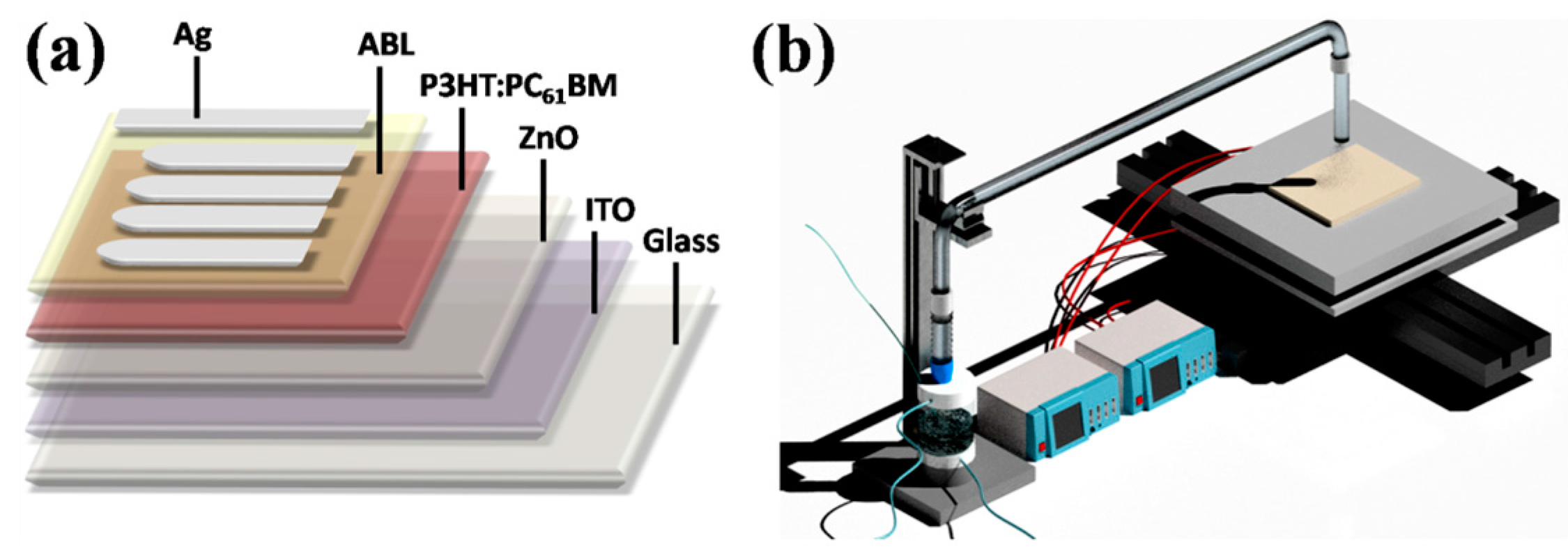
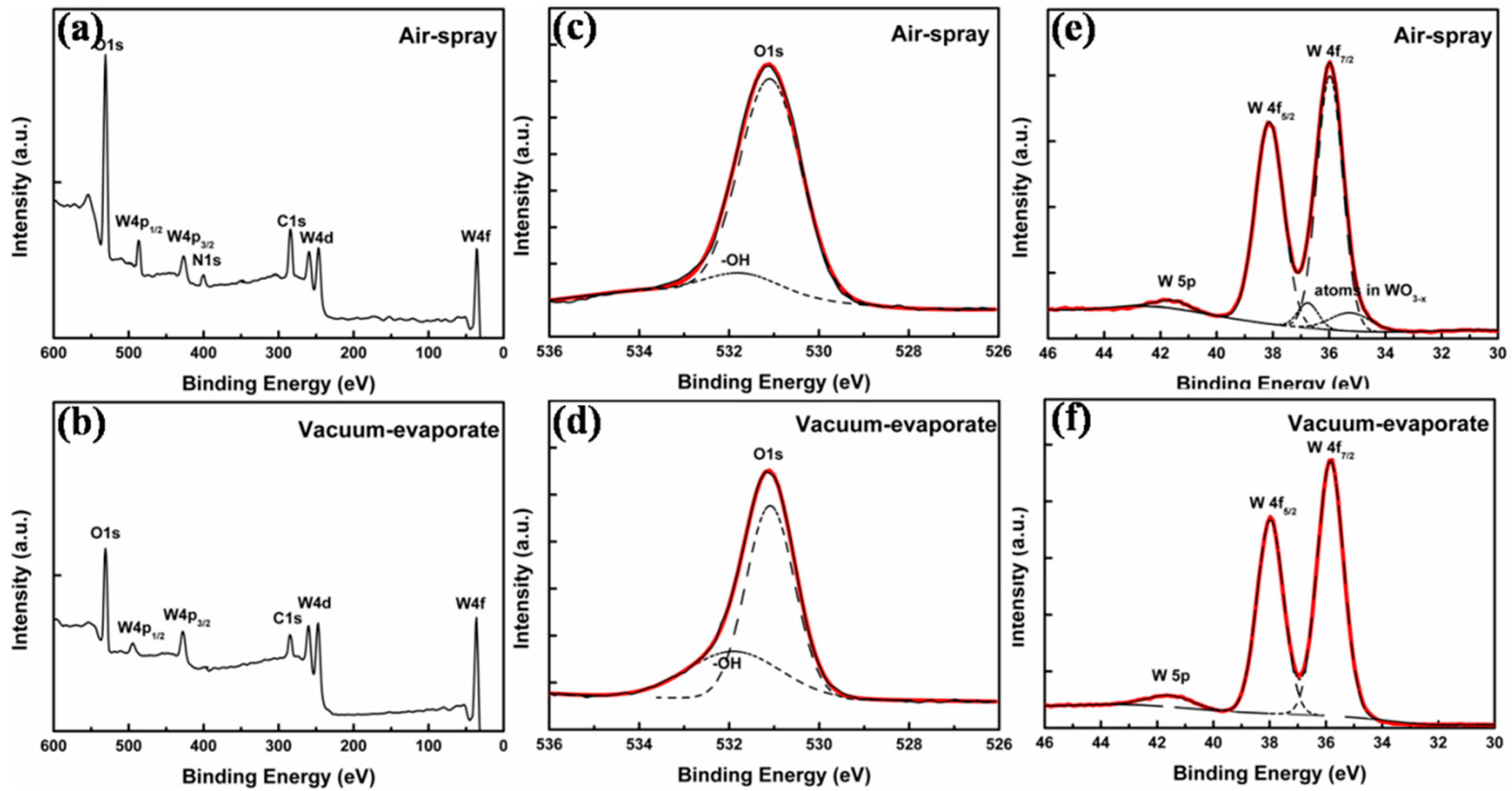
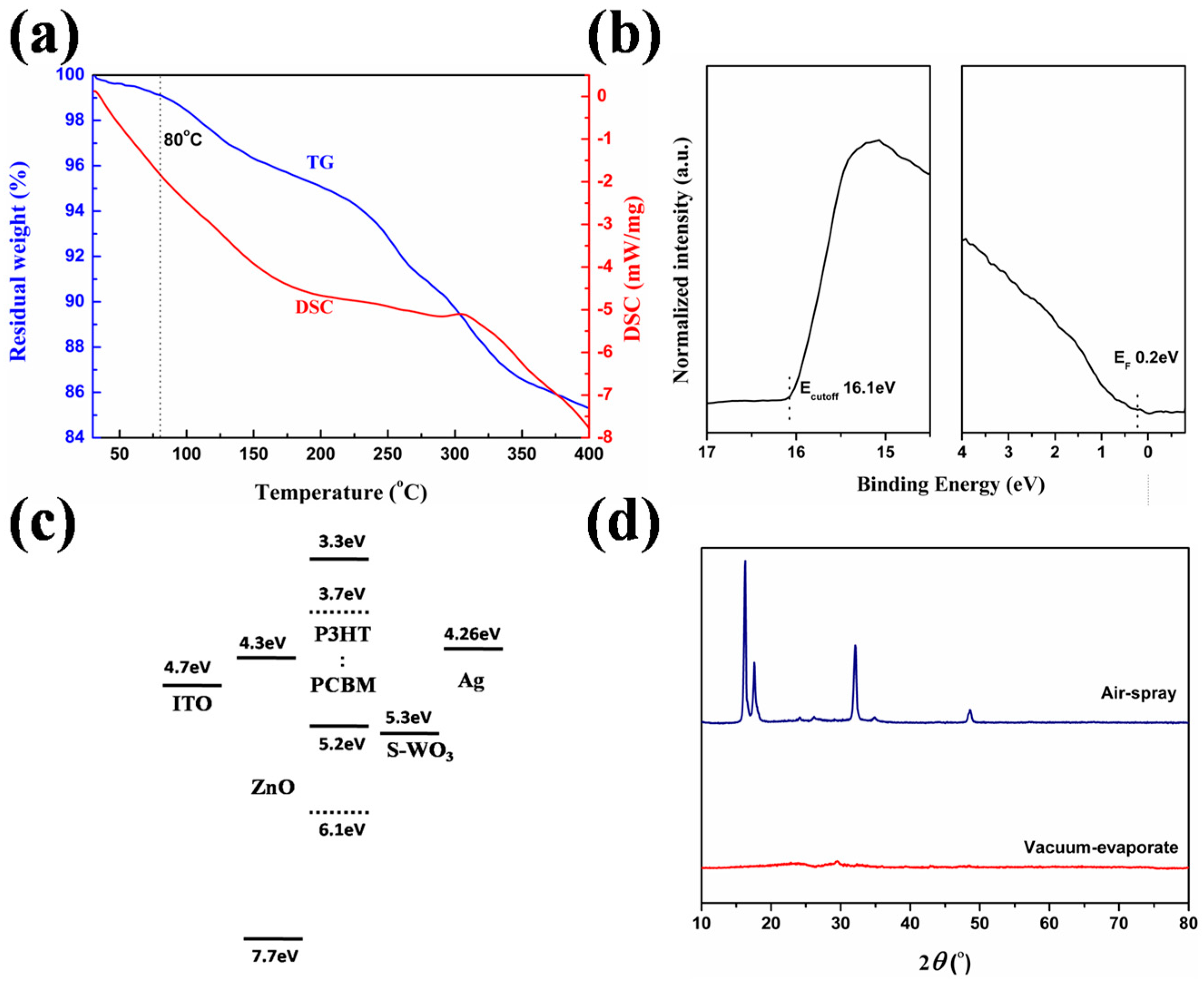
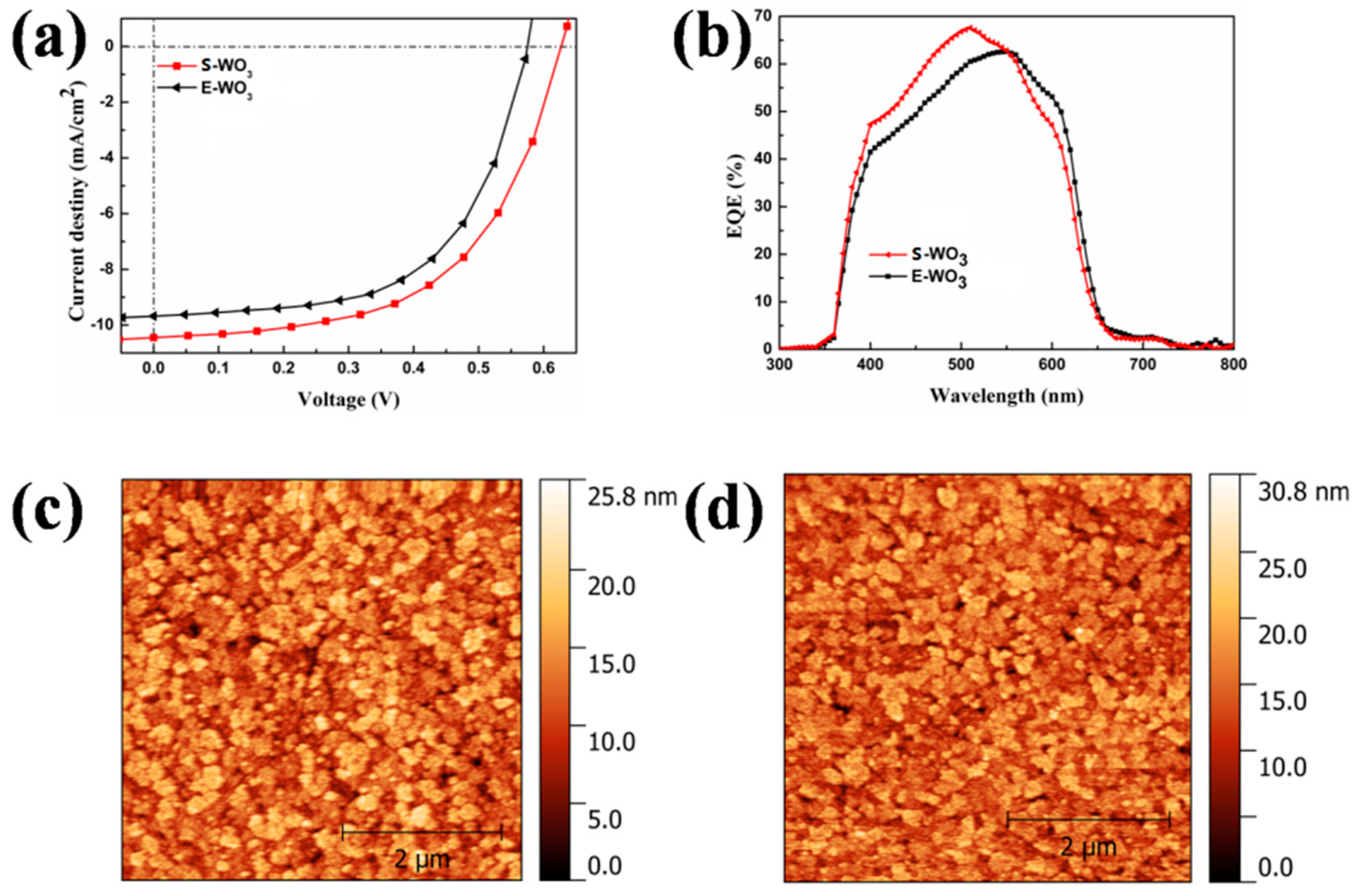

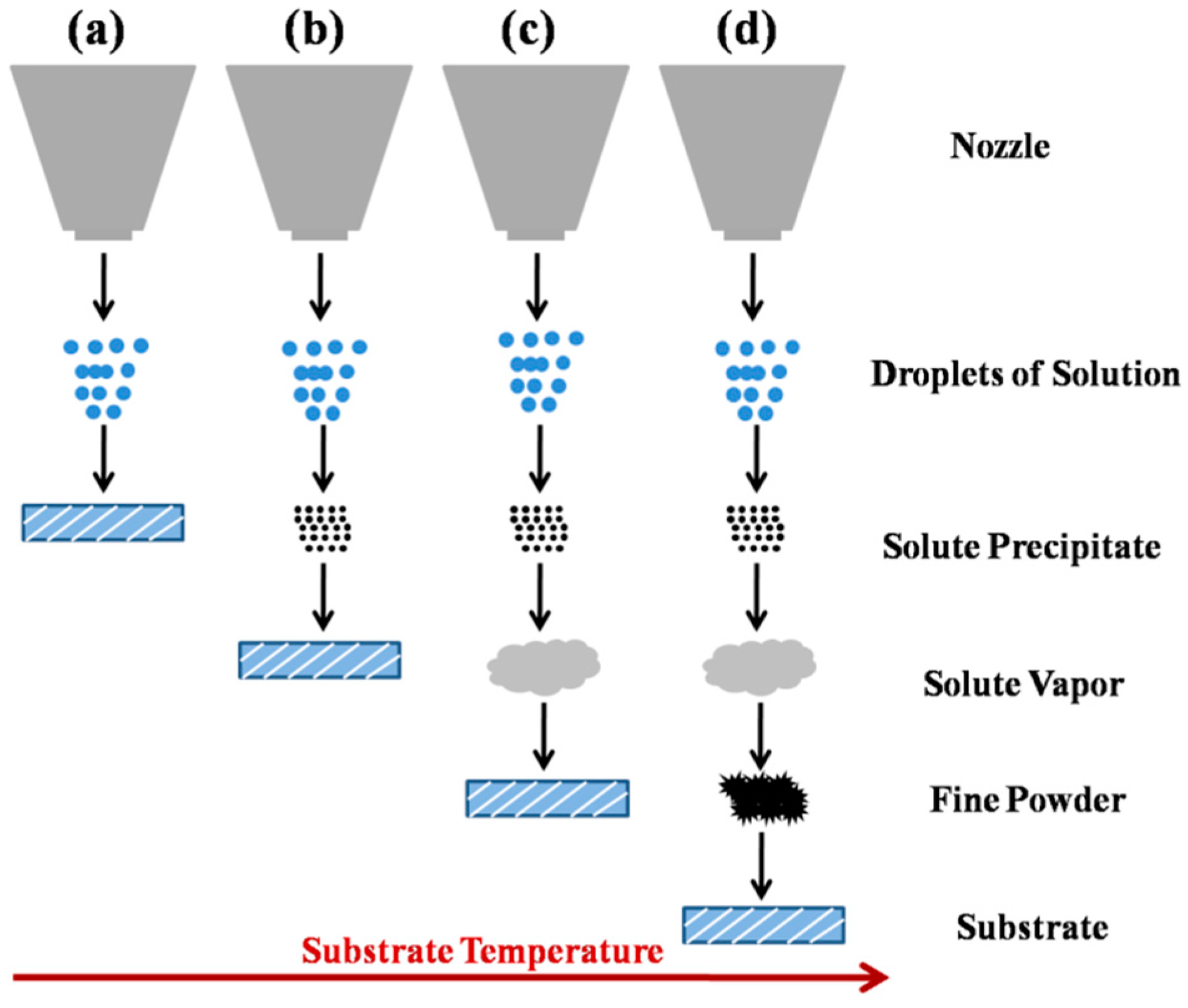
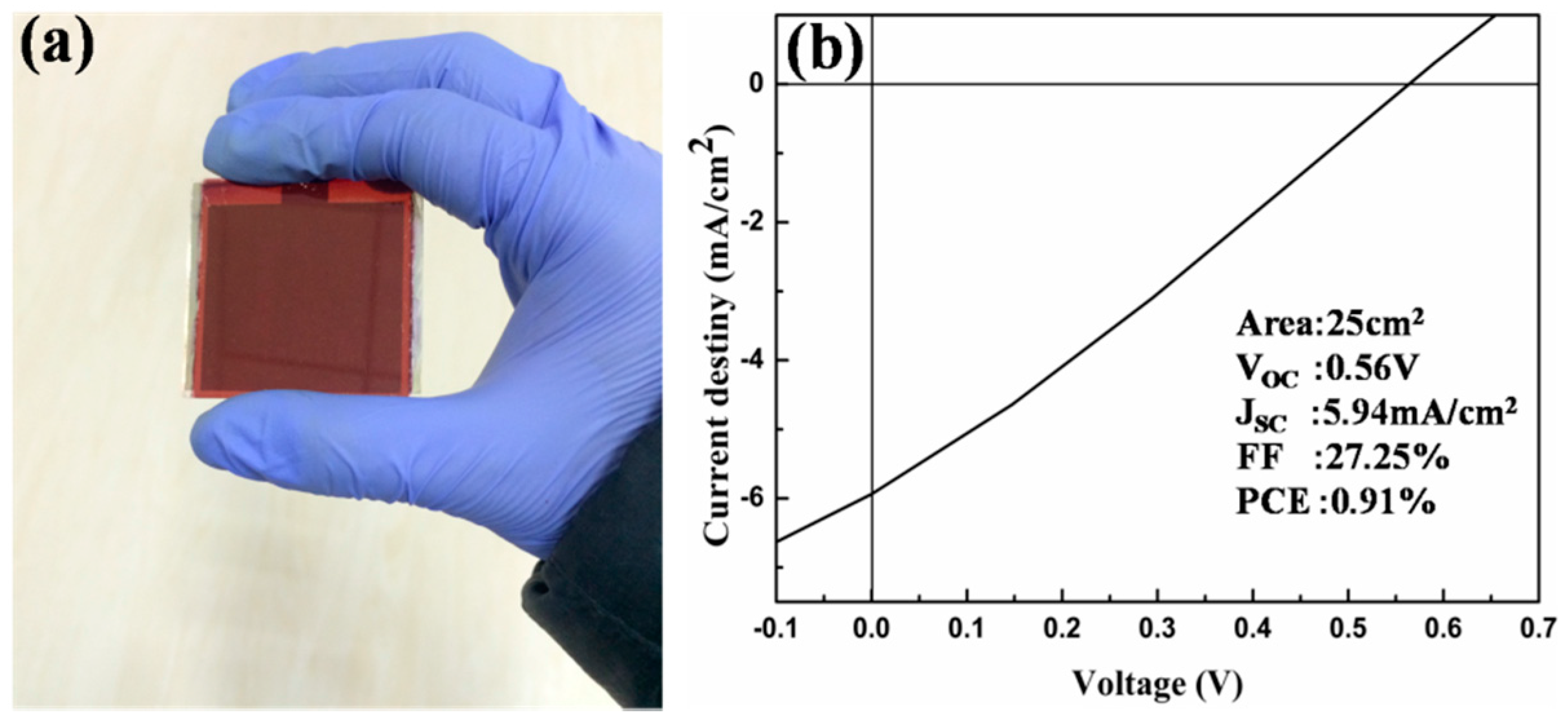
| Devices | VOC (V) | JSC (mA·cm−2) | FF (%) | PCE (%) | RS (Ω cm2) |
|---|---|---|---|---|---|
| 20 nm E-WO3 | 0.57 ± 0.01 | 9.68 ± 0.09 | 58.73 ± 1.02 | 3.27 ± 0.11 | 1.06 ± 0.15 |
| S-WO3 with concentration of AT | |||||
| 25 mg/L | 0.55 ± 0.03 | 9.58 ± 0.21 | 38.74 ± 2.62 | 2.03 ± 0.22 | 15.65 ± 1.76 |
| 100 mg/L | 0.63 ± 0.02 | 10.45 ± 0.17 | 55.48 ± 1.27 | 3.63 ± 0.13 | 1.18 ± 0.31 |
| 200 mg/L | 0.61 ± 0.02 | 10.12 ± 0.19 | 52.85 ± 1.36 | 3.27 ± 0.16 | 2.42 ± 0.73 |
| 300 mg/L | 0.61 ± 0.02 | 9.52 ± 0.14 | 49.36 ± 0.95 | 2.86 ± 0.12 | 7.84 ± 0.58 |
| Devices | R1 (Ω) | C1 (F) | R2 (Ω) | C2 (F) | R3 (Ω) |
|---|---|---|---|---|---|
| 20 nm E-WO3 | 3.32 × 105 | 1.37 × 10−9 | 1547.00 | 9.60 × 10−10 | 220.20 |
| S-WO3 with concentration of AT | |||||
| 25 mg/L | 1.78 × 106 | 1.25 × 10−9 | 2049.00 | 6.983 × 10−10 | 245.90 |
| 100 mg/L | 2.09 × 105 | 2.50 × 10−9 | 850.80 | 1.16 × 10−9 | 107.50 |
| 200 mg/L | 2.33 × 105 | 3.49 × 10−9 | 1024.00 | 1.01 × 10−9 | 73.81 |
| 300 mg/L | 4.08 × 105 | 1.55 × 10−9 | 1682.00 | 8.76 × 10−10 | 160.30 |
© 2017 by the authors. Licensee MDPI, Basel, Switzerland. This article is an open access article distributed under the terms and conditions of the Creative Commons Attribution (CC BY) license (http://creativecommons.org/licenses/by/4.0/).
Share and Cite
Ji, R.; Zheng, D.; Zhou, C.; Cheng, J.; Yu, J.; Li, L. Low-Temperature Preparation of Tungsten Oxide Anode Buffer Layer via Ultrasonic Spray Pyrolysis Method for Large-Area Organic Solar Cells. Materials 2017, 10, 820. https://doi.org/10.3390/ma10070820
Ji R, Zheng D, Zhou C, Cheng J, Yu J, Li L. Low-Temperature Preparation of Tungsten Oxide Anode Buffer Layer via Ultrasonic Spray Pyrolysis Method for Large-Area Organic Solar Cells. Materials. 2017; 10(7):820. https://doi.org/10.3390/ma10070820
Chicago/Turabian StyleJi, Ran, Ding Zheng, Chang Zhou, Jiang Cheng, Junsheng Yu, and Lu Li. 2017. "Low-Temperature Preparation of Tungsten Oxide Anode Buffer Layer via Ultrasonic Spray Pyrolysis Method for Large-Area Organic Solar Cells" Materials 10, no. 7: 820. https://doi.org/10.3390/ma10070820






